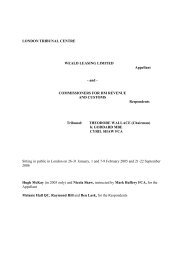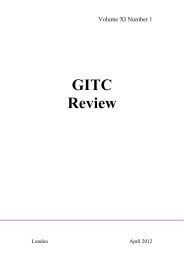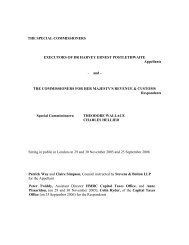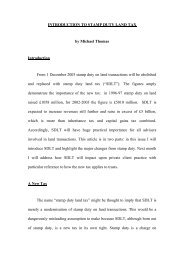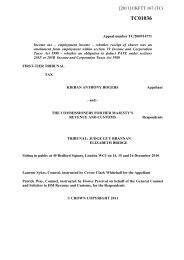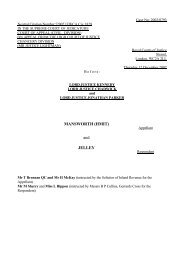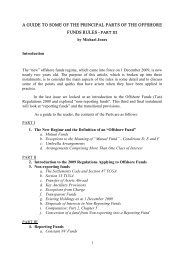Full Transcript
Full Transcript
Full Transcript
You also want an ePaper? Increase the reach of your titles
YUMPU automatically turns print PDFs into web optimized ePapers that Google loves.
CUSTOMS DUTY – classification – works of art – sculpture? – yes –<br />
correctly declared as such? – yes – appeals allowed.<br />
LONDON TRIBUNAL CENTRE<br />
HAUNCH OF VENISON PARTNERS LIMITED<br />
-and-<br />
Appellant<br />
HER MAJESTY’S COMMISSIONERS OF REVENUE AND CUSTOMS<br />
Tribunal: Richard Barlow (Chairman)<br />
Mrs Lynneth M Salisbury (Member)<br />
Sitting in public in London on 8-11 September 2008 (corrected<br />
transcripts received 2 October 2008)<br />
Conrad McDonnell of counsel instructed by Messrs Withers for the<br />
Appellant<br />
Respondents<br />
Andrew O’Connor of counsel, instructed by the Solicitor for HM Revenue<br />
and Customs for the Respondents
DECISION<br />
1. This decision relates to two appeals heard together in both of which<br />
the appellant was Haunch of Venison Partners Limited. The<br />
Appellant is a commercial gallery specialising in modern and<br />
contemporary works. The appeals both raise questions about the<br />
correct classification of works of art for the purposes of the<br />
Combined Nomenclature in Council Regulation 2658/87/EEC and<br />
the annexes thereto, being the Integrated Tariff of the European<br />
Union (the Taric).<br />
2. The first appeal relates to a review decision dated 27 September<br />
2006 upholding several C18 post clearance demand notes by which<br />
the respondents sought payment of approximately £36,000<br />
customs duty on six works by the American artist Bill Viola, on<br />
their importation into the UK, as being properly classifiable under<br />
heading 9008 30 00 as “image projectors, other than<br />
cinematographic; photographic (other than cinematographic)<br />
enlargers and reducers – other image projectors”, though we were<br />
told that classification was provisional.<br />
3. The second appeal relates to a deemed confirmation of a decision<br />
on a Binding Tariff Information classifying a work, by the deceased<br />
American artist Dan Flavin, under the nomenclature as 9405 10 28<br />
“chandeliers and other electrical ceiling or wall lighting fittings
excluding those of a kind used for lighting public open spaces or<br />
thoroughfares – other”.<br />
4. In both cases the appellant contends that the goods in question<br />
should be classified under heading 9703 00 00 “original sculptures<br />
and statuary, in any material” or alternatively 97 05 “collectors’<br />
pieces of historical interest”. The classifications asserted to be<br />
correct by the respondents give rise to a positive rate of customs<br />
duty and VAT at importation at the full rate. The classifications<br />
asserted to be correct by the appellant give rise to nil rates of duty<br />
and, in most circumstances, 5% VAT. It was agreed by both parties<br />
that the VAT would simply follow the decision of the tribunal on the<br />
customs classification issue and that no further points would arise<br />
in respect of it.<br />
5. The tribunal (differently constituted) had earlier directed that the<br />
appeal should, at this stage, relate only to whether the<br />
classification contended for by the appellant is correct, leaving it to<br />
be decided later what the correct alternative would be if we do not<br />
hold in favour of the appellant.<br />
6. There is no dispute that the works are in fact works of art, at least<br />
once they are set up for viewing. HMRC acknowledge that both Mr<br />
Viola and Mr Flavin are internationally recognised and highly<br />
regarded artists.<br />
7. The Viola works are described as six video installations, though the<br />
image is in fact recorded on a DVD. Two copies of one work were
imported so that five different ones are represented in total. Each<br />
work is shown as a film recorded on DVD. These are not films in<br />
the sense of one that might be shown in a cinema or broadcast on a<br />
television channel. They convey emotions and suggest abstract<br />
thoughts by showing human figures in stylised movements and<br />
situations without a clear narrative or story and somewhat<br />
ambiguous physical surroundings. The Tate Modern Gallery<br />
installed one of the works for us to see.<br />
8. The appellant called Mr Kevin David who is an associate director of<br />
the appellant and whose responsibilities include the installation of<br />
works at the gallery or in other premises where they are to be<br />
exhibited and at the premises of purchasers.<br />
9. In particular he has visited the Viola Studio and was able to speak<br />
from first hand knowledge about the artist’s practice. He described<br />
the works in question in the appeal in detail. He was cross<br />
examined at length.<br />
10. From that evidence we make the following findings. The Viola<br />
works are projections from DVDs which are intended to be shown<br />
only on equipment specially put together for that purpose and<br />
consist of components some of which are adapted for that purpose<br />
and some of which, though not actually adapted, are nonetheless<br />
specified and supplied as part of the work. For example, the cables<br />
used are high quality cables and the length is specified by their<br />
being supplied as part of the work. The screen on which the DVD<br />
is shown is adapted by masking the manufacturer’s logo and
masking tape of the type specified by the artist is supplied as part<br />
of the work.<br />
11. Naturally, Mr Viola does not begin by manufacturing DVDs or<br />
DVD players from scratch but each component is chosen by him<br />
and he gives precise instructions about how the work should be<br />
shown including the equipment to be used and indeed the<br />
equipment is supplied as part of the work when it is sold. The<br />
installation manuals accompanying the works consist of very<br />
detailed instructions and drawings running to several pages. The<br />
equipment is much more sophisticated than the ordinary home<br />
DVD player and the settings such as the contrast and brightness of<br />
the picture are specified and pre-set in the equipment. In effect the<br />
equipment that is used to display the work is suitable only for that<br />
purpose unless it were to be dismantled and reconfigured for some<br />
other use. Such dismantling would destroy the work as a work of<br />
art. If someone obtained a copy of one of the DVDs and played it<br />
on ordinary equipment that would not be a Viola work any more<br />
than a reproduction or a copy of an original painting would be that<br />
painting.<br />
12. These details are important to the work as a work of art<br />
because the artist has chosen them with care and as a means of<br />
ensuring that the work is shown in the way that he considers will<br />
have the effect that he intends to convey.<br />
13. The details are also essential to the authenticity of the work<br />
as an original work of art. They distinguish between a Viola
installation and an unauthentic copy which someone might<br />
attempt to make by copying the DVD.<br />
14. Most of the works are produced in small editions numbering<br />
no more than five copies of any single work.<br />
15. The works are always fully installed at the studio in the USA<br />
before they are sent to a gallery and they are taken apart for<br />
transportation and they have to be put together again and installed<br />
for display at their destination and indeed every time they are<br />
moved.<br />
16. The Flavin work can be described by its title “six alternating<br />
cool white/warm white fluorescent lights vertical and centred<br />
(1973)”, though that description does not do justice to the effect of<br />
the work once it is displayed, judging by photographs we were<br />
shown. We also viewed a different Flavin work, also consisting of<br />
fluorescent lights, specially installed at the Tate Modern for us. We<br />
express our thanks to the Tate for the trouble they took for our<br />
benefit.<br />
17. Mr David’s evidence was that Flavin works use ordinary<br />
lighting components (though of high quality) but the artist specified<br />
exactly what had to be used and how it had to be installed in much<br />
the same way as for the Viola works. Some of the works will have<br />
light fittings attached to boards or to other suitable structures and<br />
the lights themselves are taken out of the structures for<br />
transportation. The Flavin estate supplies replacement
components when required. The works are accompanied by<br />
detailed instructions drawn up by the artist. Clearly authenticity is<br />
an important issue in the case of the Flavin works because they<br />
use mainly or even entirely replaceable parts. The work’s<br />
provenance and the artist’s instructions in an original form are<br />
therefore important. Mr Flavin also adopted a policy of never<br />
supplying a duplicate of the certificates of authenticity which he<br />
supplied when he sold a work, so that authentic copies could not<br />
be made. The works are dismantled for transport when required<br />
and must be put back together as instructed by the artist.<br />
18. The appellant’s case is essentially that the works are works of<br />
art and should be classified as sculpture in the nomenclature, or as<br />
collectors pieces if that is incorrect. The respondents deny that the<br />
Viola works are sculpture but accept that the Flavin work is a work<br />
of sculpture. In respect of both the Viola works and the Flavin<br />
work the respondents also assert that, because the works are not<br />
imported in one piece but are taken apart for transportation, they<br />
should be classified according to the classification of their separate<br />
parts. The respondents deny that any of the works are collectors’<br />
pieces within the meaning of the nomenclature.<br />
19. We heard evidence from Messrs Harry Blain, a director of the<br />
appellant, Robert Cumming writer, lecturer and critic, Martin<br />
Caiger-Smith writer and consultant who is the programme leader at<br />
the Courtauld Institute of Art and Alexander Nairne Director of the<br />
National Portrait Gallery.
20. Some of those witnesses’ evidence was originally concerned<br />
with the question whether the works in question are works of art<br />
and as that is, in principle, now conceded we need not deal with it.<br />
However, despite having conceded that the works are works of art<br />
when installed for viewing HMRC did submit that they are not<br />
works of art when they are dismantled for transport and only<br />
become works of art again when they are put together for display.<br />
We regard that question as mainly a question of law but the<br />
witnesses certainly did not agree with it. Those witnesses did state<br />
that in their opinion the works in question could properly be<br />
described as sculpture.<br />
21. On the basis of the evidence we heard we find that the works<br />
in this case are properly classifiable as sculpture (as was anyway<br />
conceded in the case of the Flavin work) so far as what might be<br />
termed professional people in the art world are concerned. By that<br />
we mean critics, gallerists and other artists.<br />
22. Ms Nina Wells, registrar of the appellant, also gave evidence<br />
about some of the dealings with HMRC in connection with this case<br />
and testified to the fact that anyone who buys a Viola work receives<br />
a certificate of authenticity from the artist.<br />
Relevant Legislation
23. The general rules for interpretation of the Combined<br />
Nomenclature include the following:-<br />
1. The titles of sections, chapters and sub-chapters are<br />
provided for ease of reference only; for legal purposes,<br />
classification shall be determined according to the terms of<br />
the headings and any relative section or chapter notes and,<br />
provided such headings or notes do not otherwise require,<br />
according to the following provisions:<br />
2. (a) Any reference in a heading to an article shall be taken<br />
to include a reference to that article incomplete or<br />
unfinished, provided that, as presented, the incomplete or<br />
unfinished article has the essential character of the<br />
complete or finished article. It shall also be taken to<br />
include a reference to that article complete or finished (or<br />
falling to be classified as complete or finished by virtue of<br />
this rule), presented unassembled or disassembled.<br />
(b) Any reference in a heading to a material or substance<br />
shall be taken to include a reference to mixtures or<br />
combinations of that material or substance with other<br />
materials or substances. Any reference to goods of a given<br />
material or substance shall be taken to include a reference<br />
to goods consisting wholly or partly of such material or<br />
substance. The classification of goods consisting of more<br />
than one material or substance shall be according to the<br />
principles of rule 3.
3. When by application of rule 2(b) or for any other reason,<br />
goods are prima facie classifiable under two or more<br />
headings, classification shall be effected as follows:<br />
(a) The heading which provides the most specific<br />
description shall be preferred to headings providing a<br />
more general description. However, when two or more<br />
headings each refer to part only of the materials or<br />
substances contained in mixed or composite goods or to<br />
part only of the items in a set put up for retail sale,<br />
those headings are to be regarded as equally specific in<br />
relation to those goods, even if one of them gives a more<br />
complete or precise description of the goods.<br />
(b) Mixtures, composite goods consisting of different<br />
materials or made up of different components, and<br />
goods put up in sets for retail sale, which cannot be<br />
classified by reference to 3(a), shall be classified as if<br />
they consisted of the material or component which gives<br />
them their essential character in so far as this criterion<br />
is applicable.<br />
(c) When goods cannot be classified by reference to 3(a) or<br />
(b), they shall be classified under the heading which<br />
occurs last in numerical order among those which<br />
equally merit consideration.
4. Goods which cannot be classified in accordance with the<br />
above rules shall be classified under the heading<br />
appropriate to the goods to which they are most akin.<br />
24. The relevant provisions in Chapter 97 include the following<br />
Chapter Notes:<br />
3. Heading no 9703 does not apply to mass produced<br />
reproductions of works of conventional craftsmanship of a<br />
commercial character, even if these articles are designed or<br />
created by artists.<br />
4(a) Subject to Notes 1 to 3 above, articles of this chapter are<br />
to be classified in this chapter and not in any other chapter of<br />
the nomenclature.<br />
(b) Heading No 9706 does not apply to the preceding<br />
headings of this chapter.<br />
25. Chapter 97 has the following headings: 9701 paintings etc,<br />
9702 original engravings etc, 9703 “original sculptures and<br />
statuary, in any material”, 9704 postage stamps etc, 9705<br />
“collections and collectors’ pieces of zoological, botanical,<br />
mineralogical, anatomical, historical, archaeological,<br />
palaeontological, ethnographic or numismatic interest” and 9706<br />
antiques. Unusually it does not end with a residual heading which<br />
might have been “9707 other” if the usual pattern had been<br />
followed. The appellant argued that the evidence should satisfy us
that the works in question are works of sculpture and that<br />
therefore they fall within heading 9703.<br />
The parties argument<br />
26. Mr McDonnell cited the case of Reinhard Onnasch –v–<br />
Hauptzollamt Berlin-Packhof Case 155/84 in which the European<br />
Court of Justice held that a work by Claes Oldenberg made mainly<br />
from cardboard and polystyrene was a work of sculpture. The<br />
customs authorities had argued that because it was not made from<br />
hard materials by traditional techniques it was not a work of<br />
sculpture. The Commission had submitted that the wording of<br />
what is now heading 9703 containing, as it does, the words “of any<br />
material” and note 4(a) which gives precedence to Chapter 97 if it<br />
and headings in another Chapter both potentially apply, made it<br />
clear that the Oldenberg work should be classified as sculpture.<br />
Advocate General Lenz advised the same and the Court agreed.<br />
27. In particular the Court agreed with the Commission that the<br />
form of Chapter 97, namely its having no residual or other<br />
category, was the reason for Note 4(a) and that given that the work<br />
was a work of art, as was agreed by the parties, “where there is<br />
doubt as to the classification of an article, the preference should be<br />
given to classification in one of the headings of the chapter covering<br />
works of art, collectors’ pieces and antiques” (paragraph 10).<br />
28. The Court also said, in paragraph 9, that sculpture should be<br />
understood to refer to “all three dimensional artistic productions,
irrespective of the techniques and materials used”. At paragraph 8<br />
the Court also endorsed as correct the Commission’s view, recorded<br />
at paragraph 7, that “in so far as original artistic productions are<br />
concerned ... a liberal interpretation of the headings of Chapter [97]<br />
[should be] capable of embracing new artistic techniques”.<br />
29. The Court mentioned that the Commission had also pointed<br />
out that a requirement to classify a valuable work of art according<br />
to some other chapter might well mean that the customs duty<br />
would be applied at a rate determined by the materials used but<br />
applied to a value far in excess of the actual value of those<br />
materials as materials.<br />
30. Mr McDonnell also referred to an American case Brancusi –v-<br />
United States in which the United States Customs Court held, in<br />
1928, that an abstract work by Constantin Brancusi, “Bird in<br />
Flight” was a work of sculpture. Eighty years later it does not seem<br />
in the least surprising to find that an abstract work could be<br />
regarded as sculpture. The case is not authority binding on us but<br />
it is interesting to note that the court made the following remarks:<br />
“... the man who produced the importation is a professional<br />
sculptor, as is shown by his reputation and works and the<br />
manner in which he is considered by those competent to judge<br />
upon that subject”<br />
We emphasize those words because they show that expert evidence<br />
was regarded as relevant.
31. Mr McDonnell also relied upon Krystyna Gmurzynska-Bscher<br />
–v- Oberfinanzdirektion Köln Case C-231/89 in which the work in<br />
question was a steel plate with a fused coating of enamel-glaze<br />
colours by Lazlo Moholy-Nagy.<br />
32. In that case the ECJ held that where an object is an original<br />
work of art that precludes it from being a decoration and it must be<br />
classified under Chapter 97. The ECJ said that would be<br />
consistent with Note 4 to the Chapter. The court referred to the<br />
case law (Onnasch) establishing that a liberal interpretation of<br />
Chapter 97 must be adopted to avoid a rate of customs duty being<br />
applied to materials which have an artificially high value because<br />
they are incorporated in a work of art and in effect to recognize that<br />
the appropriate rate is nil because they are a work of art.<br />
33. Both that case and Onnasch do refer to sculpture as three<br />
dimensional.<br />
34. Mr. McDonnell relied upon those cases as support for the<br />
proposition that the intention behind Chapter 97 and in particular<br />
Note 4 is that where a work is a work of art it should be classified<br />
as such even if that means having regard to the Chapter heading<br />
which rule 1 of the General Rules normally precludes.<br />
35. Mr. O’Connor argued that the works by Mr Viola are not<br />
sculptures in the ordinary sense of that word which must be three<br />
dimensional. He argued that the work in question was only the<br />
projection emanating from the screen which is itself a flat object
and that it is simply incorrect as a matter of fact to consider the<br />
mechanism by which that image is realized as being part of a<br />
sculpture even if that mechanism does have a three dimensional<br />
form. He cited the definition of sculpture in the Shorter Oxford<br />
Dictionary (8 th Ed 1990) – “the art of making forms, often<br />
representational, in the round or in relief by chiselling stone,<br />
carving wood, modelling clay, casting metal etc” and the 10 th<br />
edition (1999) – “the art of making three dimensional representative<br />
or abstract forms, especially by carving stone or wood or by casting<br />
metal or plaster”. He also cited the New Encyclopaedia Britannica.<br />
That refers to developments making it no longer correct to identify<br />
sculpture with any special materials or techniques and goes on to<br />
add that the one thing that emerges as the central and abiding<br />
concern of sculptors is that it is “especially concerned with the<br />
creation of expressive form in three dimensions”.<br />
36. Mr O’Connor also argued that both the Viola works and the<br />
Flavin work should be classified according to their objective<br />
characteristics to be judged at the time and in the form in which<br />
the goods are presented for customs clearance. These are well<br />
established principles and he cited a number of cases to confirm<br />
that, for example Holz Geenan GmbH –v- Oberfinanzdirektion<br />
München C-309/98 and Farfalla Flemming und partner –v-<br />
Hauptzollamt München-West.<br />
37. The Commissioners’ argument is that, taking “Catherine’s<br />
Dream” (one of the Viola works) as an example, what was imported<br />
was a customized LCD screen a power supply and cables, a remote
control and DVD player, DVD and instruction manuals and several<br />
other items. Each of these items can be and should be classified as<br />
whatever they are under the tariff headings and charged at the<br />
relevant rates of duty. At this stage the Commissioners say they<br />
are not obliged to specify what the headings are or how the value of<br />
the goods would be determined because the tribunal has directed<br />
that the question to be decided first is whether and if so which of<br />
the headings in Chapter 97 the goods do fall within. However, the<br />
Commissioners do assert that the value of the items so classified<br />
will be their enhanced value not the objective value to be placed<br />
upon such items as second hand goods.<br />
38. In particular Mr. O’Connor cited Develop Dr Eisbein GmbH &<br />
Co –v- Hauptzollamt Stuttgart-West Case C-35/93. In that case the<br />
imported goods were photocopiers supplied as kits consisting of<br />
200 parts and they were declared as photocopier parts rather than<br />
as photocopiers. The ECJ confirmed, at paragraph 18 of the<br />
judgement, that when goods are presented to customs authorities it<br />
is the objective properties of the goods in terms of the tariff<br />
headings that determines their classification. It also applied the<br />
statement in the explanatory notes to the harmonized system<br />
which explains that rule 2(a) of the rules quoted in paragraph 23<br />
above is to be interpreted as meaning that goods are not presented<br />
disassembled or unassembled if they need to undergo substantive<br />
processing as well as re-assembly before they are finished<br />
products.
39. The Commissioners case is that the works in question are not<br />
works of art viewed objectively when they arrive in separate pieces<br />
and that if these works as presented to the customs authorities are<br />
treated as works of art at that stage then any importer could<br />
declare any goods to be works of art and thereby circumvent the<br />
positive rates of duty.<br />
40. Mr McDonnell replied to that submission by submitting that<br />
the objective characteristics of the works in question include the<br />
fact that they are works of art and that the situation is no different<br />
to that envisaged in the Eisbein case where it may not have been<br />
apparent to the customs officials that the pieces were a photocopier<br />
simply by looking at them but that nonetheless it was a<br />
photocopier.<br />
41. The final paragraph of the part of the judgement dealing with<br />
that issue, at paragraph 23, reads as follows:<br />
“Accordingly, it should be stated in reply to the first<br />
question that an article is to be considered to be<br />
imported unassembled or disassembled where the<br />
component parts, that is the parts which may be<br />
identified as components intended to make up the<br />
finished product, are all presented for customs<br />
clearance at the same time, and no account is to be<br />
taken in that regard of the assembly technique or the<br />
complexity of the assembly method”.<br />
42. Mr McDonnell argued in the alternative that the works in<br />
question are collectors’ pieces of historical interest because of the<br />
eminence of the artists concerned. In reply Mr O’Connor submitted
that, however eminent an artist may be, that does not mean that all<br />
his works are of historical interest and, at most, only those that<br />
break new ground or represent a particular turning point in the<br />
artist’s career can be of historical interest.<br />
Discussion<br />
43. The first issue we have to consider is whether the Viola works<br />
can be classified as sculpture within the meaning given to that<br />
word in Chapter 97 heading 97 03. We accept Mr O’Connor’s<br />
submission that the decision must be based on the objective<br />
characteristics of the goods as presented and which the importer<br />
has declared to be sculptures.<br />
44. The Onnasch case is very relevant as it established that a<br />
liberal interpretation of the headings should be adopted because of<br />
the absence of a residual heading. As we have already noted, in the<br />
Gmurzynska-Bscher case the ECJ, as well as repeating that a<br />
liberal interpretation should be adopted, also read note 4 of the<br />
Chapter Notes as requiring that were there is doubt about a<br />
classification of a work that is in fact a work of art, preference<br />
should be given to one of the Chapter 97 headings over those of any<br />
other Chapter. We read that to mean that once a work is identified<br />
as a work of art then a prima facie case for classification under one<br />
of the headings is all that is needed to bring it within one of those<br />
headings.
45. We do not think it is necessary to ignore rule 1 of the general<br />
rules quoted in paragraph 23 above and there is no indication in<br />
the Chapter Notes to Chapter 97 that suggests we should.<br />
However, we hold that we can read the headings in their context<br />
and so the heading for sculptures, being associated as it is with the<br />
headings for paintings, drawings, collages, engravings, prints and<br />
lithographs; is clearly intended to apply to sculptures which are<br />
works of art rather than just any object that someone chooses to<br />
call a sculpture. The heading also specifies that it must be an<br />
original sculpture.<br />
46. It is for the tribunal to decide what objects should be<br />
classified as sculpture but, as with any classification issue, that<br />
may require the tribunal to have regard to expert evidence. Some<br />
of the more technical classification issues clearly could require<br />
expert evidence from, for example, chemists or metallurgists and<br />
we see no reason why experts in the arts should not also inform the<br />
tribunal’s decisions relating to Chapter 97.<br />
47. The evidence we have heard which was given by eminent<br />
experts has satisfied us that we should hold that the Viola works<br />
are sculptures and, as is often the case for sculptures of the most<br />
traditional kind, that conclusion is not contradicted by the fact that<br />
the works may have been made in editions of small numbers. Each<br />
was individually made by Mr Viola and is an original work even<br />
though the DVD may have contained the same digital material for<br />
each copy of the edition.
48. We also hold that the Viola works are three dimensional.<br />
They do not consist of a two dimensional image on a screen. Mr<br />
Viola chose all the components he supplied as part of the work<br />
deliberately and as part of the artistic process with a view to<br />
achieving his artistic intention with the greatest effect. He did not<br />
intend that the works should be shown on just any randomly<br />
selected DVD player in just any room or space in which that player<br />
happened to be. No issue arises as to whether the Flavin work is<br />
three dimensional.<br />
49. We reject the respondents’ arguments that the works in this<br />
case were (in the case of the Viola works) or will be (in the case of<br />
the Flavin work), when viewed objectively, not the sculptures<br />
unassembled or disassembled. If a particular interpretation of<br />
legislation renders it incapable of being applied then that is a good<br />
argument for giving it a different interpretation that does not have<br />
that effect. But legislation cannot be interpreted on the basis that<br />
it should be made as easy as possible for the authorities to apply it,<br />
even if that means interpreting it in an absurd manner which the<br />
respondents’ argument invites us to do. We regard it as absurd to<br />
classify any of these works as components ignoring the fact that<br />
the components together make a work of art.<br />
50. The Commissioners’ fears that importers might declare just<br />
anything as works of art, which was the basis of their argument,<br />
are in any case grossly exaggerated. If someone declares something<br />
under Chapter 97 which is not obviously an art work, then he can<br />
be challenged to prove that it is and will of course fail. The burden
of proof will be on the importer and the commissioners will be able<br />
to call expert evidence.<br />
51. It stretches the objective characteristics principle too far to<br />
say that a work of art is no longer a work of art if it is dismantled<br />
for transportation and the commissioners’ argument was, we hold,<br />
entirely inconsistent with both the interpretative rules and the<br />
Eisbein case. If their argument in this case is correct then rule 2(a)<br />
of the general rules would be virtually meaningless.<br />
52. We do not agree that the works in question are collectors<br />
pieces within the meaning of heading 97 05, in that respect we<br />
agree with the commissioners’ submissions that if works of art do<br />
need to fall within that heading because they do not fall within any<br />
of the other headings in the Chapter, then they must be significant<br />
innovations in themselves or at least a particularly significant<br />
development in that artist’s practice in order to qualify as historic<br />
pieces.<br />
Conclusion<br />
53. The appeals are allowed. The tribunal exercises its powers<br />
under section 14(1)(a)(ii) and 16(5) of the Finance Act 1994. The<br />
commissioners’ decisions concerning the rate of duty applicable to<br />
the Viola works are quashed and the tribunal substitutes its own<br />
decision that the goods are correctly to be classified as coming<br />
within heading 97 03 00 00 with the rate of duty being “free”. The<br />
Binding Tariff Information in respect of the Flavin work is quashed
and substituted by the tribunal’s decision that the correct rate of<br />
duty will be “free” under the same heading.<br />
54. The respondents are directed to pay the appellant’s cots on<br />
the standard basis to be determined by the High Court, if not<br />
agreed.<br />
Richard Barlow<br />
CHAIRMAN<br />
Release date: 11 Dec 2008



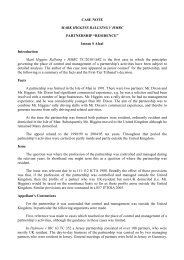
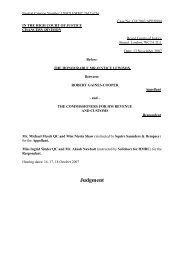
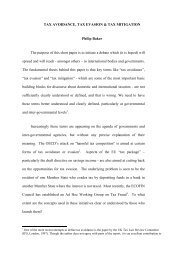
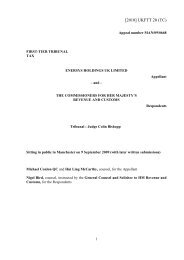
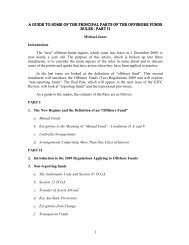
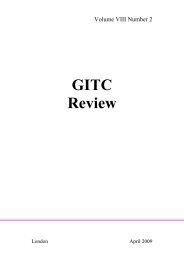
![Mohammed Siddiq Khan v. HMRC [2006] EWCA Civ 89](https://img.yumpu.com/45700564/1/184x260/mohammed-siddiq-khan-v-hmrc-2006-ewca-civ-89.jpg?quality=85)
